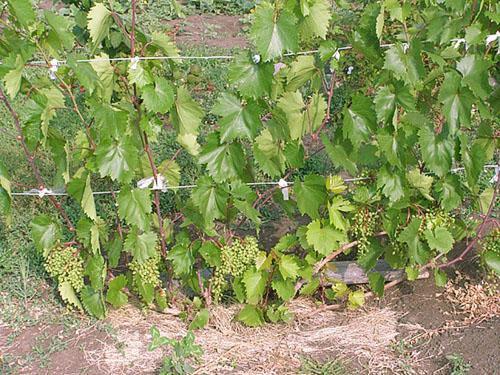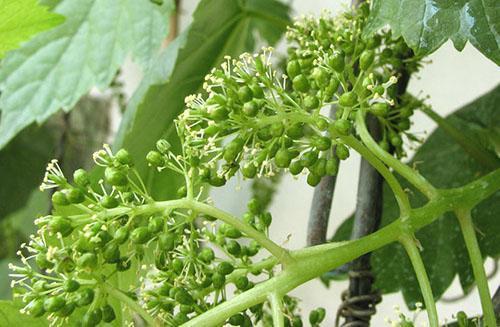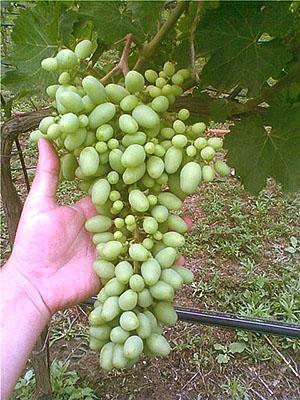How to take care of summer grapes to get a good harvest?
 In summer, grapes bloom, bunches are laid and ripen, as well as shoots and dormant buds, which will be harvested next year. The high temperature and the abundance of sunlight determines the rapid growth and development of the vines, respectively, and there is a lot of work to control and adjust the bushes.
In summer, grapes bloom, bunches are laid and ripen, as well as shoots and dormant buds, which will be harvested next year. The high temperature and the abundance of sunlight determines the rapid growth and development of the vines, respectively, and there is a lot of work to control and adjust the bushes.
Flowering grapes

 If the weather is rainy and cold during flowering, the berry setting is low. Reason: in rainy weather, a sticky secret is washed off, to which pollen adheres. A relatively low temperature significantly increases the germination time. All this leads to the peas of grapes, when small, seedless berries are present on the grove along with large berries.
If the weather is rainy and cold during flowering, the berry setting is low. Reason: in rainy weather, a sticky secret is washed off, to which pollen adheres. A relatively low temperature significantly increases the germination time. All this leads to the peas of grapes, when small, seedless berries are present on the grove along with large berries.
The appearance of the brush suffers from peas, which is important for table varieties: a non-marketable appearance. Although for all varieties, insufficient pollination reduces the yield! And varieties with functionally female flowers, in which their own pollen is sterile, will hardly yield without additional pollination and without transferring pollen from other varieties of berries.
 In this case, we carry out artificial pollination. We make two shovels of wood or plywood, on which we attach a rabbit skin with a stapler or small nails. You can take two rabbit tails and nail them to sticks.
In this case, we carry out artificial pollination. We make two shovels of wood or plywood, on which we attach a rabbit skin with a stapler or small nails. You can take two rabbit tails and nail them to sticks.
Now, alternately, with light touches, we collect pollen from the inflorescence of the pollinator variety and transfer it to the pollinated grove. Periodically knock the shoulder blades against each other, getting rid of the collected sterile pollen. We carry out the action on dry inflorescences, after the dew has subsided or the raindrops have dried.
Watering grapes in summer
 Depends on the weather, the state of plantings, soil. Watering by sprinkling, drip into the root zone, into the pits near the bushes or along the grooves. We select a suitable watering method based on local conditions. At the dacha, with a small vineyard area, it is convenient to dig in a piece of pipe or a plastic bottle when planting. Thus, we water the grapes, and not the weeds nearby, and in small doses: water comes to the right place, unproductive evaporation is minimal.
Depends on the weather, the state of plantings, soil. Watering by sprinkling, drip into the root zone, into the pits near the bushes or along the grooves. We select a suitable watering method based on local conditions. At the dacha, with a small vineyard area, it is convenient to dig in a piece of pipe or a plastic bottle when planting. Thus, we water the grapes, and not the weeds nearby, and in small doses: water comes to the right place, unproductive evaporation is minimal.
 The amount of watering - depending on the needs of the plant and the weather. If the lower leaves begin to turn yellow, water immediately. On light soils, moisture penetrates into the depth faster, but it is necessary to water more often, since it is less well retained. On heavy soils during the rainy season, there is an excess of moisture. In this case, it is necessary to drain, loosen the soil for air access in order to avoid the death of the roots.
The amount of watering - depending on the needs of the plant and the weather. If the lower leaves begin to turn yellow, water immediately. On light soils, moisture penetrates into the depth faster, but it is necessary to water more often, since it is less well retained. On heavy soils during the rainy season, there is an excess of moisture. In this case, it is necessary to drain, loosen the soil for air access in order to avoid the death of the roots.
It is convenient to combine watering and feeding, using a solution of organic and mineral fertilizers instead of water.
Sprinkling irrigation has a significant disadvantage, since, correctly watering in the summer, we still have reflected spray from the ground. And it is there that the oidium pathogens remain, which will fall on the leaves with drops ...
Fertilizer
 The culture takes out a lot of nutrients from the soil, they need to be replaced with fertilizer. Organic fertilizers we bring in in the fall, in the summer - except when watering, when we add diluted urine, mullein or other to the water. When feeding the grapes in July and later, we do not add mineral nitrogen: the growing season will increase, the ripening of berries will be postponed, the plant will drive the mass and will not have time to enter the dormant stage. Winter hardiness will be like a banana. Maybe a little higher, but still not enough ...
The culture takes out a lot of nutrients from the soil, they need to be replaced with fertilizer. Organic fertilizers we bring in in the fall, in the summer - except when watering, when we add diluted urine, mullein or other to the water. When feeding the grapes in July and later, we do not add mineral nitrogen: the growing season will increase, the ripening of berries will be postponed, the plant will drive the mass and will not have time to enter the dormant stage. Winter hardiness will be like a banana. Maybe a little higher, but still not enough ...
The removal of potassium is large, we mainly introduce chlorine-free forms of its fertilizers - chlorine harms the grapes.
A lot of phosphorus is required, we take into account its availability in the soil. The fact is that the high content of copper, manganese, lime in the soil reduces the availability of phosphorus for plants, the roots cannot "pull" it out of the soil. Part of it is good to give in the form of foliar dressing, that is, spray the leaves with a solution of phosphorus salts.
In general, the method of foliar feeding has a number of advantages: batteries are used more economically, since they are not bound by the soil and go directly to the plant. It is convenient to feed the plant with iron with a solution of ferrous sulfate: its deficiency disrupts photosynthesis and leads to chlorosis. Particularly good is foliar feeding with a solution of trace elements, which the plant needs in small quantities, but which cannot be dispensed with. Top dressing with such a solution before flowering increases the number of berries set. In this case, the solution should be diluted, and its acidity is close to neutral in order to avoid burning the leaves.
Protection of grapes from pests and diseases
 The high temperature, alas, favors the development of not only grapes. When describing how to care for grapes in summer, you should definitely pay attention to protection against diseases and pests... This is a large, ramified topic, so we have posted articles dedicated to this topic on our website. And in this text we will just mention in passing that there are a large number of diseases and pests of grapes that can reduce or destroy the entire crop. Spraying with medicinal preparations. combined with spraying with solutions of stimulating and nutrient substances saves costs.
The high temperature, alas, favors the development of not only grapes. When describing how to care for grapes in summer, you should definitely pay attention to protection against diseases and pests... This is a large, ramified topic, so we have posted articles dedicated to this topic on our website. And in this text we will just mention in passing that there are a large number of diseases and pests of grapes that can reduce or destroy the entire crop. Spraying with medicinal preparations. combined with spraying with solutions of stimulating and nutrient substances saves costs.
Green works
 The unmistakable formation of the bush is of great importance: this is how we achieve the correct ratio of the root part, leaf surface, buds and shoots, inflorescences. Any deviation from the optimum leads to a decrease in yield and a weakening of the bush. And not only this year, but the next few!
The unmistakable formation of the bush is of great importance: this is how we achieve the correct ratio of the root part, leaf surface, buds and shoots, inflorescences. Any deviation from the optimum leads to a decrease in yield and a weakening of the bush. And not only this year, but the next few!
The main pruning is usually done in the spring, but there is enough work in the summer. To accelerate ripening, the grapes are chased: we shorten the shoots, leaving 10-12 leaves above the bunch. In addition to chasing, other methods are used to accelerate the ripening of berries:
- Ringing. In June, under the lower brush, remove the bark and cambium with a ring, 3-5 mm.
- We turn a long shoot into a ring, inclined or horizontal.
- Twist the vine. Above the last bunch, twist (do not cut off, just twist) the vine. In addition to accelerating ripening, the bunch will be sweeter.
It is worth noting that if we need to accelerate ripening, maybe we just made a mistake when choosing a variety for planting?
We carry out pinching of grapes, removing, partially or completely, fast-growing small shoots from the buds on the ponds of this year. They thicken the bush, reducing the illumination, which reduces sugar content and yield, and leads to disease damage. Stepsons grow stronger when the grape bush is unloaded, when there are "extra" substances not used for filling berries and laying buds, growth of shoots.
Formation is carried out all the time, this is not only responsible, but also a complex complex of techniques in the description.
A video demonstrating pruning techniques will help to properly care for grapes in July. Observing the crown of the shoot will help to understand whether the bush is loaded enough. Normally, it remains curved until mid-August. The bending is caused by uneven growth of wood.Aligning the crown is a sign of overloading the bush, it is urgently necessary to remove excess shoots, otherwise the budding will be disturbed and the harvest of both this year and the next 2-3 years will suffer.